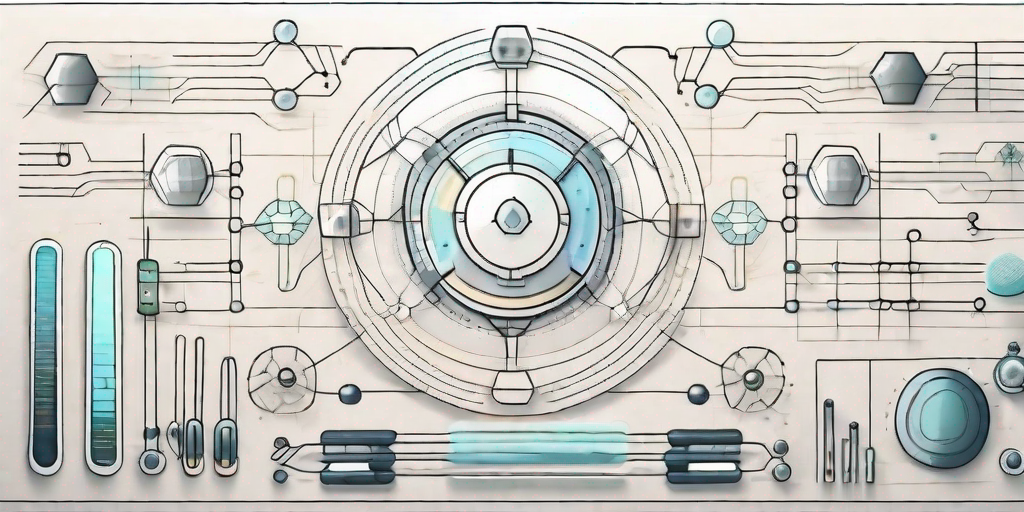Strategy Futurist's Role in Understanding Nanotechnology Explained

Strategy Futurist's Role in Understanding Nanotechnology Explained
Nanotechnology is the science and technology of manipulating matter at the molecular and atomic levels. It has revolutionized numerous industries, from healthcare to electronics, and its impact continues to grow. As businesses navigate this rapidly evolving field, the role of a strategy futurist becomes crucial in understanding and interpreting nanotechnology's implications.
Understanding the Basics of Nanotechnology
Before delving into the role of a strategy futurist, it's essential to grasp the fundamentals of nanotechnology. At its core, nanotechnology involves working with materials and devices at the nanoscale, which is roughly one to one hundred nanometers in size. To put this into perspective, a nanometer is a billionth of a meter. By manipulating and controlling structures and properties at such a minuscule level, scientists can create entirely new materials and devices with enhanced functionalities.
Nanotechnology encompasses a wide range of fields, including physics, chemistry, biology, materials science, and engineering. It enables scientists to design and engineer materials with specific properties, such as increased strength, improved conductivity, or enhanced sensitivity. Some remarkable applications of nanotechnology include self-cleaning surfaces, nanorobots for targeted drug delivery, and ultra-high-performance batteries.
One fascinating area of nanotechnology is the development of self-cleaning surfaces. Imagine a world where you never have to worry about cleaning your windows or bathroom tiles again. With nanotechnology, this could become a reality. Scientists have been able to create surfaces that repel dirt and water by manipulating the nanoscale structures of the materials. These surfaces, known as superhydrophobic surfaces, have a rough texture at the nanoscale, which causes water droplets to bead up and roll off, taking dirt and contaminants with them. This not only saves time and effort but also has significant implications for maintaining cleanliness in various industries, such as healthcare and food processing.
Another exciting application of nanotechnology is the use of nanorobots for targeted drug delivery. Traditional drug delivery methods often result in the medication affecting healthy cells along with the targeted ones, leading to unwanted side effects. Nanorobots, on the other hand, can be designed to specifically target diseased cells while leaving healthy cells unharmed. These tiny robots, typically made of biocompatible materials, can navigate through the bloodstream, find their target, and deliver the medication directly to the affected cells. This targeted approach not only improves the effectiveness of the treatment but also minimizes the risk of side effects, revolutionizing the field of medicine.
Furthermore, nanotechnology has paved the way for the development of ultra-high-performance batteries. As our reliance on portable electronic devices continues to grow, the need for longer-lasting and more efficient batteries becomes increasingly crucial. Nanotechnology offers solutions by enabling the design and engineering of battery materials at the nanoscale. This allows for improved energy storage and faster charging times. For example, researchers have developed nanomaterials that can store more energy per unit volume, leading to smaller and lighter batteries with increased capacity. Additionally, nanotechnology has also been used to enhance the conductivity of battery materials, resulting in faster charging and discharging rates. These advancements in battery technology have the potential to revolutionize not only consumer electronics but also electric vehicles and renewable energy storage systems.
Role of a Strategy Futurist in Interpreting Nanotechnology
With such vast potential, nanotechnology presents both opportunities and challenges for businesses. This is where a strategy futurist comes into play. A strategy futurist is a visionary and strategist who helps organizations understand and navigate emerging trends and technologies, such as nanotechnology.
The role of a strategy futurist in interpreting nanotechnology is multifaceted. Firstly, they stay abreast of the latest advancements and research in nanotechnology, providing businesses with up-to-date knowledge and insights. They analyze and interpret the implications of these advancements and help organizations identify potential applications and opportunities in their specific industries.
For example, let's consider the field of medicine. A strategy futurist specializing in nanotechnology can help healthcare organizations explore the use of nanomaterials for targeted drug delivery. By understanding the unique properties of nanoparticles, such as their ability to penetrate specific cells or tissues, the futurist can assist in developing innovative therapies that minimize side effects and maximize treatment efficacy.
Furthermore, a strategy futurist helps businesses assess the potential risks and ethical considerations associated with nanotechnology. As nanotechnology introduces new materials and processes, it is essential to consider the environmental and health impacts. A strategy futurist can guide organizations in adopting responsible practices and integrating nanotechnology in a sustainable manner.
Consider the manufacturing industry, where nanotechnology is revolutionizing production processes. A strategy futurist can help companies evaluate the environmental footprint of nanomaterials and ensure that their implementation aligns with sustainability goals. They can also assist in developing protocols for the safe handling and disposal of nanomaterials, minimizing any potential harm to workers or the environment.
Moreover, a strategy futurist plays a crucial role in fostering collaboration and knowledge-sharing among different stakeholders. They facilitate discussions and partnerships between researchers, industry experts, policymakers, and other relevant parties. By bringing together diverse perspectives, the futurist helps create a holistic understanding of nanotechnology's potential and promotes the development of responsible and inclusive strategies.
In conclusion, the role of a strategy futurist in interpreting nanotechnology extends beyond simply providing information. They are instrumental in guiding businesses towards harnessing the opportunities presented by nanotechnology while mitigating risks and ensuring ethical considerations. Through their expertise, foresight, and collaborative approach, strategy futurists help organizations navigate the complex landscape of nanotechnology and shape a sustainable and prosperous future.
Impact of Nanotechnology on Different Industries
Nanotechnology's impact is far-reaching and extends across various industries. Let's explore some of the sectors that are benefiting from this cutting-edge technology:
1. Healthcare
Nanotechnology has revolutionized healthcare by enabling targeted drug delivery, improved diagnostics, and regenerative medicine. Nanoparticles can be engineered to deliver medications directly to specific cells or tissues, increasing treatment efficacy and minimizing side effects. Moreover, nanosensors can detect diseases early on, leading to quicker interventions and better outcomes.
In addition to targeted drug delivery, nanotechnology has also paved the way for personalized medicine. By analyzing an individual's genetic makeup, researchers can design nanoscale drug delivery systems that are tailored to their specific needs. This approach has the potential to revolutionize the treatment of diseases like cancer, where each patient's tumor is unique and requires a customized treatment plan.
Furthermore, nanotechnology has opened up new possibilities in regenerative medicine. Nanomaterials can be used to create scaffolds that support the growth of new tissues and organs, providing hope for patients in need of transplants. By mimicking the natural environment of cells, these nanoscale scaffolds can promote tissue regeneration and repair damaged organs.
2. Electronics
The electronics industry has greatly benefited from nanotechnology. Miniaturization of electronic components has become possible, leading to smaller and more efficient devices. Nanoscale materials, such as graphene, have exceptional electrical conductivity, opening doors to faster processors, flexible displays, and more powerful batteries.
One of the most exciting applications of nanotechnology in electronics is the development of wearable devices. By integrating nanosensors into clothing or accessories, these devices can monitor vital signs, track physical activity, and even detect early signs of diseases. This technology has the potential to revolutionize healthcare by providing continuous, real-time monitoring of patients' health.
Nanotechnology has also played a crucial role in the advancement of flexible electronics. By using nanoscale materials, such as carbon nanotubes, researchers have been able to create flexible displays that can be bent, rolled, or even stretched without losing functionality. This opens up new possibilities for wearable technology, foldable smartphones, and electronic devices that can conform to any shape.
3. Energy
Nanotechnology plays a pivotal role in advancing renewable energy sources, such as solar cells and energy storage systems. Nanomaterials can improve the efficiency of solar panels by capturing a broader spectrum of light and converting it into electricity more effectively. Furthermore, nanotechnology is instrumental in developing high-capacity batteries and fuel cells for efficient energy storage.
In the field of solar energy, nanotechnology has enabled the development of thin-film solar cells that are lightweight, flexible, and highly efficient. By incorporating nanomaterials, such as perovskites, into the solar cell structure, researchers have been able to achieve higher conversion efficiencies and reduce manufacturing costs. This has the potential to make solar energy more accessible and affordable for a wider range of applications.
Moreover, nanotechnology has revolutionized energy storage systems. By utilizing nanomaterials, such as graphene, researchers have been able to enhance the performance of batteries and fuel cells. These advancements have led to the development of high-capacity batteries that can store more energy and deliver it more efficiently. This is crucial for the widespread adoption of renewable energy sources, as it addresses the intermittent nature of solar and wind power.
Overall, nanotechnology has had a profound impact on various industries, including healthcare, electronics, and energy. Its ability to manipulate matter at the nanoscale has opened up new possibilities for targeted drug delivery, miniaturization of electronic devices, and advancements in renewable energy sources. As research and development in nanotechnology continue to progress, we can expect even more exciting applications and innovations in the future.
How a Strategy Futurist Prepares You for the Nanotech Revolution
The rise of nanotechnology presents a unique set of challenges and opportunities for businesses. By engaging a strategy futurist, organizations can effectively prepare for the nanotech revolution. Here's how a strategy futurist can help:
1. Scenario Planning
A strategy futurist employs scenario planning techniques to envision plausible future scenarios influenced by nanotechnology. By exploring various possibilities, businesses can identify potential disruptions and plan their strategies accordingly. This proactive approach allows organizations to adapt and thrive in an ever-changing technological landscape.
2. Innovation and R&D Guidance
With their in-depth understanding of nanotechnology, strategy futurists provide guidance on innovation and research and development (R&D) initiatives. By identifying emerging trends and breakthroughs, they help organizations allocate resources effectively and invest in projects that align with their long-term goals.
3. Collaboration and Partnerships
A strategy futurist facilitates collaboration and partnerships between businesses and leading research institutions or nanotechnology experts. This synergy allows organizations to leverage external expertise, access cutting-edge resources, and stay at the forefront of nanotechnology advancements.
Advantages of Understanding Nanotechnology for Future Business Planning
1. Competitive Advantage: Businesses that understand and embrace nanotechnology gain a competitive edge by innovating new products and processes that outperform their competitors. Stay ahead of the curve by incorporating nanotechnology into your business strategy.
2. Market Opportunities: Nanotechnology opens doors to new market opportunities across various industries. By identifying and capitalizing on these opportunities, businesses can expand their customer base and revenue streams.
3. Environmental Sustainability: Nanotechnology offers solutions for sustainable development, enabling businesses to reduce their environmental footprint. By adopting nanotechnology in manufacturing processes, organizations can develop greener products and contribute to a more sustainable future.
4. Risk Mitigation: Understanding the risks associated with nanotechnology allows businesses to proactively address safety, regulatory, and ethical concerns. By incorporating responsible practices and complying with regulations, organizations can protect their reputation and build trust with consumers.
As a strategy futurist, embracing nanotechnology is not just about staying ahead of the competition; it's about being part of a technological revolution that has the potential to transform industries and improve lives. By understanding and harnessing the power of nanotechnology, businesses can position themselves for success in the ever-evolving landscape of tomorrow.
FAQ
1. What is nanotechnology?
Nanotechnology is the science and technology of manipulating matter at the molecular and atomic levels. It involves working with materials and devices at the nanoscale, which is roughly one to one hundred nanometers in size.
2. What are some applications of nanotechnology?
Nanotechnology has a wide range of applications, including self-cleaning surfaces, targeted drug delivery using nanorobots, and the development of ultra-high-performance batteries. It also has implications for industries such as healthcare, electronics, and energy.
3. How can a strategy futurist help businesses in understanding and navigating nanotechnology?
A strategy futurist stays updated on the latest advancements and research in nanotechnology and provides businesses with knowledge and insights. They can help identify potential applications and opportunities in specific industries, assess risks and ethical considerations, and foster collaboration among stakeholders.
Contact a Strategy Futurist for your event
Are you ready to take your organization's understanding of nanotechnology to the next level? Look no further than Dr. Mark van Rijmenam, a renowned Strategy Futurist who can provide invaluable insights and guidance for your next event. With his expertise and foresight, Dr. Mark van Rijmenam can help your business navigate the complex landscape of nanotechnology and unlock its full potential.
Whether you are seeking to explore the opportunities presented by nanotechnology or want to proactively address the associated risks and ethical considerations, Dr. Mark van Rijmenam is the speaker you need. His engaging and thought-provoking presentations will leave your audience inspired and equipped with the knowledge to make informed decisions.
Don't miss out on the chance to have Dr. Mark van Rijmenam as a speaker at your event. Contact him today by completing the form below, and we will be in touch within 24 hours to discuss how he can tailor his expertise to meet your specific needs. Prepare your organization for the nanotech revolution and secure your competitive advantage with the guidance of a Strategy Futurist.
Thanks for your inquiry
We have sent you a copy of your request and we will be in touch within 24 hours on business days.
If you do not receive an email from us by then, please check your spam mailbox and whitelist email addresses from @thedigitalspeaker.com.
In the meantime, feel free to learn more about The Digital Speaker here.
Or read The Digital Speaker's latest articles here.





